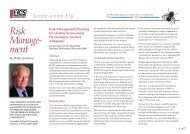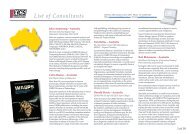Manual for Diagnosis of Screw-worm Fly - xcs consulting
Manual for Diagnosis of Screw-worm Fly - xcs consulting
Manual for Diagnosis of Screw-worm Fly - xcs consulting
Create successful ePaper yourself
Turn your PDF publications into a flip-book with our unique Google optimized e-Paper software.
Cochliomyia macellaria<br />
Agriculture, Fisheries and Forestry - Australia<br />
Young females <strong>of</strong> C. macellaria generally have cuticular hydrocarbons <strong>of</strong> shorter chain length<br />
than Co. hominivorax with alkanes <strong>of</strong> chain length 27 (particularly i-methylheptacosane) being<br />
dominant. Also present are substantial quantities <strong>of</strong> n-nonacosane and i-methylnonacosane.<br />
Data <strong>for</strong> males and <strong>for</strong> older flies are not available.<br />
Distinguishing features <strong>for</strong> C. bezziana cuticular<br />
hydrocarbons (Fig. 32)<br />
Because <strong>of</strong> changes in cuticular hydrocarbon composition due to age, sex and probably<br />
geographic source, <strong>for</strong> reliable species identification it is best to consider the cuticular<br />
hydrocarbon pattern as a whole rather than to rely on one or two components. Thus cuticular<br />
hydrocarbon values <strong>for</strong> a supposed C. bezziana should match reasonably well with the<br />
values given in the Table and the traces in Fig. 32 <strong>for</strong> most if not all major components.<br />
However, allowance <strong>for</strong> changes in cuticluar hydrocarbon composition with age should be<br />
made using the values and the table as a yardstick. Since these values represent the limits<br />
<strong>for</strong> each component, flies <strong>of</strong> intermediate age should have intermediate hydrocarbon values.<br />
Culicular hydrocarbon changes cease with death so storage <strong>of</strong> a dead fly will not produce<br />
any further change in hydrocarbon composition.<br />
In spite <strong>of</strong> the cautionary note above, the following comments can be made: young<br />
C. megacephala, C. saffranea and Co. macellaria generally have shorter chain length<br />
hydrocarbons than does C. bezziana. Heptacosanes, especially i-methylheptacosane, are far<br />
more abundant than in C. bezziana, whereas hydrocarbons <strong>of</strong> chain length greater than 30<br />
are much more abundant in the latter. In view <strong>of</strong> the changes with age <strong>for</strong> the cuticular<br />
hydrocarbons <strong>of</strong> C. bezziana and Co. hominivorax, it is likely that similar changes occur with<br />
these other species, however, it is unlikely that these would be such as to cause older flies <strong>of</strong><br />
these species to mimic C. bezziana.<br />
Newly emerged Co. hominivorax flies contain cuticular hydrocarbons dominated by<br />
nonacosanes which are only relatively minor components <strong>of</strong> C. bezziana and lack the longer<br />
chain material present in the latter. Older male Co. hominivorax flies develop large quantities<br />
<strong>of</strong> pentacosanes and heptacosanes which are absent or at low levels in C. bezziana. Older<br />
females <strong>of</strong> Co. hominivorax do develop some longer chain alkanes but not to the extent that<br />
C. bezziana does. They also have much more i-methylheptacosane and n-nonacosane but<br />
less 2-methyltriacontane than does C. bezziana.<br />
The single most diagnostic component <strong>of</strong> the cuticular hydrocarbons <strong>of</strong> C. bezziana is<br />
2-methyltriacontane, which is a major component in young and old males and females but is<br />
present at only low levels in the other species. Similarly i-methyltritriacontane is present in all<br />
stages <strong>of</strong> C. bezziana but occurs elsewhere only in old Co. hominivorax females.<br />
51




